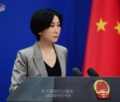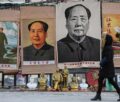Chinese jets ‘dangerously intercepted’ Canadian surveillance aircraft on UN Mission

Canadian Defense Minister Bill Blair has accused China of conducting a “dangerous and reckless” interception of a Canadian surveillance aircraft on UN mission to monitor sanctions against North Korea.
Blair responded to a report by Canada’s Global News that Chinese fighter jets intercepted a Royal Canadian Air Force (RCAF) military airplane in an “aggressive manner” while the latter was flying over international waters off the coast of China on Monday.
The news outlet said a missile-carrying Chinese jet came as close as five meters from the Canadian aircraft – a distance deemed by military analysts to be leaving “very little margin for error.”
Reporters from Radio Canada and Global News were on board the CP-140 Aurora maritime patrol aircraft which was on a U.N. mission to monitor sanctions against North Korea.
“I am very concerned about the unprofessional way in which this was done,” Blair told reporters in Ottawa.
“It was quite frankly dangerous and reckless. And those types of behaviors are not ever acceptable and we will express that to the People’s Republic of China in the most appropriate way,” he said.
Beijing responded by lodging a protest with the Canadian government saying the CP-140 “illegally intruded” into airspace claimed by China, violating its sovereignty and threatening national security.
“The truth of the matter is that a Canadian military aircraft traveled thousands of miles to China’s doorstep to provoke trouble, and China dealt with it in accordance with the law and regulations,” China’s foreign ministry spokesperson Mao Ning told a news conference, accusing Canada of spreading fake news.
Global News quoted the commander of RCAF’s 1st Air Division Maj. Gen. Iain Huddleston, who was also on board, as saying that the Chinese jets also launched multiple flares near the front of the Aurora.
“They became very aggressive and to a degree we would deem it unsafe and unprofessional,” Huddleston told the broadcaster.
The Canadian surveillance aircraft was taking part in U.N. Operation NEON to monitor shipping lanes in the East China Sea for signs of vessels that may be violating the oil embargo against North Korea.
The Aurora is “Canada’s primary airborne intelligence, surveillance, and reconnaissance aircraft,” according to the Canadian government website. The RCAF has a fleet of 14 CP-140 Aurora planes.
Risk of collision
According to Global News, Chinese jets “intercepted the Canadian plane consistently for multiple hours during the more than eight-hour-long mission.”
One of the Chinese aircraft was “aggressively flying back and forth in close proximity while appearing to put the Canadian plane in its blind spot,” it said.
“Such close air encounters were common,” said Collin Koh, a regional military analyst at the S. Rajaratnam School of International Studies in Singapore.
“Those that happened but were unreported were not counted. But 5m is awfully close and for aircraft, that’s very little margin for error,” Koh told Radio Free Asia.
“A variety of aerodynamic factors can lead to collision, that’s why a safe separation is required,” the analyst said. “Unless the PLA aviator is doing scripted aerobatic stunts to wow the crowd, this kind of operational behavior is uncalled for.”
This is not the first time Canada has accused the Chinese air force of conducting dangerous maneuvers against its military aircraft. In June 2022, it said Chinese jets were “buzzing,” or flying extremely close and fast, a RCAF’s airplane multiple times.
A spokesperson for the Canadian Department of National Defence said at that time that the incidents were “of concern and of increasing frequency,” with around 60 such interceptions reported in a six-month period from December 2021 to June 2022.
There have been many close encounters between Chinese and foreign military airplanes in recent years.
The U.S. Indo-Pacific Command said in December that a Chinese J-11 fighter pilot performed an unsafe maneuver during an intercept of a U.S. Air Force RC-135 aircraft, forcing the RC-135 to “take evasive maneuvers to avoid a collision.”
In March 2022, U.S. F-35 fighters reportedly had at least one close contact with China’s J-20 stealth fighters over the East China Sea.
The worst incident occurred in April 2001 when a Chinese F-8 fighter jet collided with a U.S. Navy EP-3 Aries II surveillance plane over the South China Sea, killing the Chinese pilot. The U.S. airplane had to make an emergency landing on China’s Hainan island and its 24 crew members were detained for 11 days before being released.
–RFA report, Oct 17, 2023
https://www.rfa.org/english/news/china/canada-china-intercept-10172023021603.html
-
Book Shelf
-
 Book Review
DESTINY OF A DYSFUNCTIONAL NUCLEAR STATE
Book Review
DESTINY OF A DYSFUNCTIONAL NUCLEAR STATE
- Book ReviewChina FO Presser Where is the fountainhead of jihad?
- Book ReviewNews Pak Syndrome bedevils Indo-Bangla ties
- Book Review Understanding Vedic Equality….: Book Review
- Book Review Buddhism Made Easy: Book Review
- Book ReviewNews Elegant Summary Of Krishnamurti’s teachings
- Book Review Review: Perspectives: The Timeless Way of Wisdom
- Book ReviewNews Rituals too a world of Rhythm
- Book Review Marx After Marxism
- Book Review John Updike’s Terrorist – a review
-
-
Recent Top Post
-
 NewsTop Story
What Would “Total Victory” Mean in Gaza?
NewsTop Story
What Would “Total Victory” Mean in Gaza?
-
 CommentariesTop Story
The Occupation of Territory in War
CommentariesTop Story
The Occupation of Territory in War
-
 CommentariesTop Story
Pakistan: Infighting in ruling elite intensifies following shock election result
CommentariesTop Story
Pakistan: Infighting in ruling elite intensifies following shock election result
-
 CommentariesTop Story
Proforma Polls in Pakistan Today
CommentariesTop Story
Proforma Polls in Pakistan Today
-
 CommentariesTop Story
Global South Dithering Away from BRI
CommentariesTop Story
Global South Dithering Away from BRI
-
 News
Meherabad beckons….
News
Meherabad beckons….
-
 CommentariesTop Story
Hong Kong court liquidates failed Chinese property giant
CommentariesTop Story
Hong Kong court liquidates failed Chinese property giant
-
 CommentariesTop Story
China’s stock market fall sounds alarm bells
CommentariesTop Story
China’s stock market fall sounds alarm bells
-
 Commentaries
Middle East: Opportunity for the US
Commentaries
Middle East: Opportunity for the US
-
 Commentaries
India – Maldives Relations Nosedive
Commentaries
India – Maldives Relations Nosedive
-
AdSense code



















